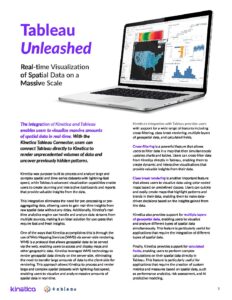Tableau + Kinetica
Tableau is transforming the business world by making it easy to visualize and understand data. However, with large datasets, streaming data and more complex queries, enterprise users can find themselves struggling with slow performance and long wait times as the underlying database struggles to keep up.
Geospatial Visualization for Tableau
Out of the box, Tableau provides excellent geospatial visualization for small and manageable data sets. It pulls down data from the source and uses client-side technologies to deliver an interactive data exploration experience. But when you have hundreds of thousands, or even millions of data points, modern BI tools simply can’t visualize that data due to the natural limitations of client-side rendering.
Kinetica Geospatial Visualization for Tableau, a brand new extension from Kinetica, changes the game, giving you visualization at virtually unlimited scale for geospatial data in Tableau. Instead of shipping data down from your data warehouse, the extension uses Kinetica’s Web Map Service (WMS) endpoint to leverage server-side rendering. This enables visualizations on massive datasets in real time — transforming your data into a small image layer on top of a basemap. With every pan and zoom on the map, Kinetica dynamically renders images on your live data source and sends them to the map.

Impossibly fast geospatial visualization in Tableau – visualize to millions of data points in sub-second time
The result is incredibly fast geospatial visualization in Tableau that scales to millions of data points with ease.
Connecting to Tableau
Kinetica has been designed for interoperability and plays well within an enterprise data infrastructure environment. Kinetica’s ODBC and JDBC connectivity along with SQL-92 support make it simple to connect with Tableau workbooks. With the ‘Replace Data Source’ feature, you can seamlessly switch to using Kinetica as the data source without further changes to operational Tableau workbooks.
Kinetica is designed for enterprise-grade security, reliability, availability, and scalability. Authentication and authorization features such as LDAP and user/group/role-based access control ensures that data is always secure. Kinetica supports high availability with inter-cluster active-active configuration and data replication. A distributed, scale-out architecture with tiered memory management across VRAM, system memory, and disk ensures scalability.





